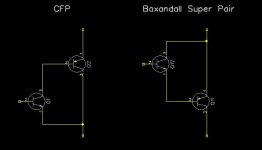Hello
I was wondering what special is in the blameless amplifiers so I decided to create my own (as many mabers here).
I decided to go:
-input stage like in B.C. book
-vas same as old yamaha amps
-3 emiter fallower
So basicly nothing new and nothing special, but I must say that I am very happy with this amp. Bellow some papers. Bias in this kind of setup is bit overcompensated as I prefer for safety reasons.
There is many improvements availible to make the amp ''nicer'' on the paper/measurements but I have listened it for a good while and I like it.
I have tested many setups for BG7 (2xLTP + cascoded VAS and etc) but this setup was sounding the best for me.
The prototype was showing bit lower THD than final version becouse I dedided to adjust a bit h2 and h3 spectrum to the prefered one.
On the 3k-3.1k modulated signals the IMD products are lowering similar to thd spectrum - I suspect that this kind of setup is ok.
I was wondering what special is in the blameless amplifiers so I decided to create my own (as many mabers here).
I decided to go:
-input stage like in B.C. book
-vas same as old yamaha amps
-3 emiter fallower
So basicly nothing new and nothing special, but I must say that I am very happy with this amp. Bellow some papers. Bias in this kind of setup is bit overcompensated as I prefer for safety reasons.
There is many improvements availible to make the amp ''nicer'' on the paper/measurements but I have listened it for a good while and I like it.
I have tested many setups for BG7 (2xLTP + cascoded VAS and etc) but this setup was sounding the best for me.
The prototype was showing bit lower THD than final version becouse I dedided to adjust a bit h2 and h3 spectrum to the prefered one.
On the 3k-3.1k modulated signals the IMD products are lowering similar to thd spectrum - I suspect that this kind of setup is ok.
Attachments
-
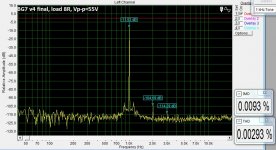 1k.jpg117.7 KB · Views: 397
1k.jpg117.7 KB · Views: 397 -
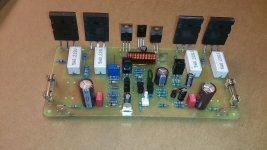 pcb.jpg110.2 KB · Views: 339
pcb.jpg110.2 KB · Views: 339 -
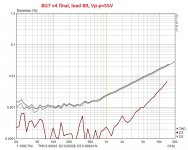 thd 55v.jpg86.3 KB · Views: 124
thd 55v.jpg86.3 KB · Views: 124 -
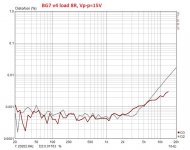 thd 15v prototyp.jpg78.8 KB · Views: 108
thd 15v prototyp.jpg78.8 KB · Views: 108 -
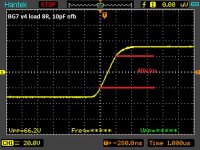 sr.jpg73.5 KB · Views: 113
sr.jpg73.5 KB · Views: 113 -
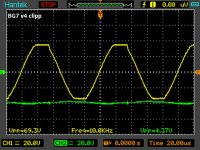 clip.jpg80.3 KB · Views: 358
clip.jpg80.3 KB · Views: 358 -
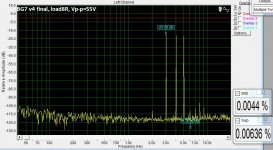 345k.jpg116.3 KB · Views: 371
345k.jpg116.3 KB · Views: 371 -
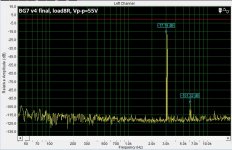 3k 3.1k.jpg101 KB · Views: 373
3k 3.1k.jpg101 KB · Views: 373 -
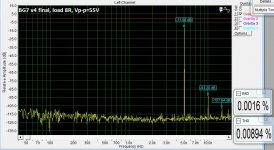 5k.jpg118.3 KB · Views: 392
5k.jpg118.3 KB · Views: 392 -
BG7 v4.2 final.zip795.5 KB · Views: 140
Last edited:
Member
Joined 2009
Paid Member
Thanks.
Yamaha have been used cpf vas for ages with good results. I found the performance similar to standard EF vas.
I had to try ''the blame'' style amplifier and must say it is really good perfomer.
Yamaha have been used cpf vas for ages with good results. I found the performance similar to standard EF vas.
I had to try ''the blame'' style amplifier and must say it is really good perfomer.
I think what Self called blameless is LTP with CM, VAS with emitter follower enhancement and EF2 or CFP, and no cascade and triple OPS. So this one is very nice amp, but I think is not what Self meant for blameless.
Who says what Blameless has to look like?
A quote directly from my copy of the Audio Amplifier Design Handbook by Douglas Self, First edition 1998 printing, pages 57-58:
"The Concept of the blameless ampifier
Here I introduce the concept of what I have chosen to call a Blameless audio power amplifier. This is an amplifier designed so that all the easily-defeated distortion mechanisms have been rendered negligible. (Note that the word Blameless has been carefully chosen to not imply Perfection, but merely the avoidance of known errors).
.....
The importance of the Blameless concept is that it represents the best distortion performance obtainable from straightforward class-B. This performance is stable and repeatable, and varies little with transistor type as it is not sensitive to variable quantities such as beta.
Blamelessness is a condition that can be defined with precision, and is therefore a standard other amplifiers can be judged against. A Blameless design represents a stable point of departure for more radical designs, such as the Trimodal concept in Chapter 9. This may be the most important use of the idea."
Though Mr Self discusses the LTP+Enhanced VAS+EF2 OPS design almost exclusively in his treatment on amplifier design I don't think the original intent was to dictate what a Blameless design has to look like. I think that the main tenet was to simply eliminate / render inconsequential his 'Eight Distortions' which is what makes the design Blameless, irrespective of topology or design details.
That said, I think the design can very easily be called Blameless if things have been properly optimized to ensure minimal distortion. For that mater, almost any design or topology could be made to achieve the Blameless definition. Blameless is a concept, not a hard-and-fast topology.
I think what Self called blameless is LTP with CM, VAS with emitter follower enhancement and EF2 or CFP, and no cascade and triple OPS. So this one is very nice amp, but I think is not what Self meant for blameless.
A quote directly from my copy of the Audio Amplifier Design Handbook by Douglas Self, First edition 1998 printing, pages 57-58:
"The Concept of the blameless ampifier
Here I introduce the concept of what I have chosen to call a Blameless audio power amplifier. This is an amplifier designed so that all the easily-defeated distortion mechanisms have been rendered negligible. (Note that the word Blameless has been carefully chosen to not imply Perfection, but merely the avoidance of known errors).
.....
The importance of the Blameless concept is that it represents the best distortion performance obtainable from straightforward class-B. This performance is stable and repeatable, and varies little with transistor type as it is not sensitive to variable quantities such as beta.
Blamelessness is a condition that can be defined with precision, and is therefore a standard other amplifiers can be judged against. A Blameless design represents a stable point of departure for more radical designs, such as the Trimodal concept in Chapter 9. This may be the most important use of the idea."
Though Mr Self discusses the LTP+Enhanced VAS+EF2 OPS design almost exclusively in his treatment on amplifier design I don't think the original intent was to dictate what a Blameless design has to look like. I think that the main tenet was to simply eliminate / render inconsequential his 'Eight Distortions' which is what makes the design Blameless, irrespective of topology or design details.
That said, I think the design can very easily be called Blameless if things have been properly optimized to ensure minimal distortion. For that mater, almost any design or topology could be made to achieve the Blameless definition. Blameless is a concept, not a hard-and-fast topology.
Hello
I was wondering what special is in the blameless amplifiers so I decided to create my own (as many mabers here).
I decided to go:
-input stage like in B.C. book
-vas same as old yamaha amps
-3 emiter fallower
Looks actually very good. I also like a CFP VAS arrangement, though I never used it in my designs so far 🙂 Congratulations Borys!
Cheers,
Valery
A quote directly from my copy of the Audio Amplifier Design Handbook by Douglas Self, First edition 1998 printing, pages 57-58:
"The Concept of the blameless ampifier
Here I introduce the concept of what I have chosen to call a Blameless audio power amplifier. This is an amplifier designed so that all the easily-defeated distortion mechanisms have been rendered negligible. (Note that the word Blameless has been carefully chosen to not imply Perfection, but merely the avoidance of known errors).
.....
The importance of the Blameless concept is that it represents the best distortion performance obtainable from straightforward class-B. This performance is stable and repeatable, and varies little with transistor type as it is not sensitive to variable quantities such as beta.
Blamelessness is a condition that can be defined with precision, and is therefore a standard other amplifiers can be judged against. A Blameless design represents a stable point of departure for more radical designs, such as the Trimodal concept in Chapter 9. This may be the most important use of the idea."
Though Mr Self discusses the LTP+Enhanced VAS+EF2 OPS design almost exclusively in his treatment on amplifier design I don't think the original intent was to dictate what a Blameless design has to look like. I think that the main tenet was to simply eliminate / render inconsequential his 'Eight Distortions' which is what makes the design Blameless, irrespective of topology or design details.
That said, I think the design can very easily be called Blameless if things have been properly optimized to ensure minimal distortion. For that mater, almost any design or topology could be made to achieve the Blameless definition. Blameless is a concept, not a hard-and-fast topology.
You are right and you are wrong in the same time. As he used always the same configuration with very small variation, everybody take this as blameless configuration, and for wile that is called blameless, it's the amp not the concept any more. Self did not use what he thought is not necessary and still to satisfies his blameless concept, as cascade, triple output, symmetric design, CFA ...
Looks actually very good. I also like a CFP VAS arrangement, though I never used it in my designs so far 🙂 Congratulations Borys!
Cheers,
Valery
Valery, I think that was called Baxandall super pair, not CFP, if I am right.
By the way, Borys used very strange (at list for me) current mirror, what's that diode over there?
Damir
Valery, I think that was called Baxandall super pair, not CFP, if I am right.
By the way, Borys used very strange (at list for me) current mirror, what's that diode over there?
Damir
Damir, you're right. I was not attentive enough at a first glance.
The diode, I believe, helps with clipping, preventing VAS saturation (it is off while LTP is balanced and the signal is not high enough to open it). As an idea 🙂
Attachments
- Status
- Not open for further replies.
- Home
- Amplifiers
- Solid State
- BG7 v4.2 - my own blame
